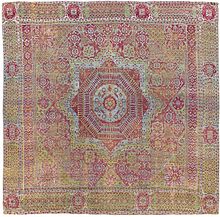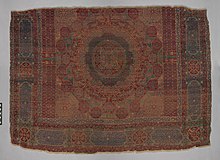207:, who played an influential role in Mamluk art patronage, would have supported the crafts of the newly arrived weavers. Since all the Mamluk carpets that survive are from the late fifteenth century onwards, there is no way to confirm whether Sultan Qaitbay had utilized the expertise of the foreign weavers to revive a once established tradition of carpet manufacturing or to introduce an entirely new one. After the 1517 Ottoman conquest of the Mamluk Sultanate in Egypt, the geometric compositions of Mamluk carpet designs were eventually abandoned and the curvilinear floral motifs were adopted in favor of the Ottoman court’s popular taste in ornamentation.
214:
124:
20:
153:
178:
Although a
Cairene center of production has long been established as the origin of Mamluk carpet weaving, disputes regarding the stylistic origins of these carpets continue. Scholars argue that Mamluk carpets represent not only external influences, but also foreign technology introduced to Egypt by
160:
The configuration of most Mamluk carpets can be simplified to a single central component radiating outwards from the core of the rug, which is either framed by the outer border or flanked by oblong panels often subdivided into tripartite shapes echoing the geometric design of the central component.
144:
datable to the late fifteenth/early sixteenth century; type 2) the rectangular main background consists of a central element flanked by oblong panels that are further divided into two, three, or five medallions with designs echoing the central element, similar to the arrangement of the Mamluk rug
110:
Mamluk carpets were used domestically as well as imported. Domestically, this new form of interior decoration was made for both religious and residential structures. During processions, these carpets were also used to line the streets; one account notes that during one of the Mamluk parades,
195:
Turkmans; in the aftermath of this event, some artisans chose to remain in their chief city, Tabriz, and continued weaving as witnessed years later by the
Venetian traveler who compared the carpets of Tabriz to those of Cairo, while other artisans must have sought employment elsewhere.
35:
carpets started from the second half of the fifteenth century until the middle of the sixteenth century, and continued even after the
Ottoman conquest of Egypt in 1517. The group of carpets produced in this period were initially called "Damascene" carpets after their attribution to
139:
categorized arrangements of Mamluk carpets and subdivided them into three main groups according to their main background: type 1) the quadrangular main background has a small squared pattern in each of the four corners, such as the Mamluk carpet at the
165:
datable to the first half of the sixteenth century. The outer borders, a chief identifying feature of all Mamluk carpets, are consistently lined with medallions alternating with oval cartouches. Mamluk carpets have often been described as having a
102:(in Egypt) means the rugs were Cairene (or rather Egyptian). The carpet fragments found in Fustat as well as the several accounts by the travelers and the historian undoubtedly place a center of carpet production in Cairo.
179:
Iranian or
Central Asian workers. The possibility of foreign craftsmen being in Cairo during the Mamluk period is based on the complex political situation between the Mamluks, Ottomans, and Turkman states of
161:
In some cases the oblong panels contain rows of stylized cypresses, palm trees, and an umbrella-shaped leaf design, a common motif in Mamluk carpets; for example, the
Kelekian Mamluk rug owned by the
149:(c. 1500-1550); type 3) the large carpet with a main background is subdivided into multiple sections and medallions, like the famous 'Simonetti' Carpet from the Metropolitan Museum of Art(c. 1500).
135:. Mamluk Carpets have distinctive features in their design, often dominated by geometric motifs and were colored in mostly red with accents of blues, yellows, and greens.
199:
The artisans could have moved to the
Ottoman and Mamluk capitals since the Mamluks had previously offered refuge to notables from Iran, such as Sultan Ahmad of the
170:
quality because of how the central design forms a series of interlacing stars and polygons around it, whereby each shape is further subdivided and decorated.
213:
479:
68:
in 1474 when he noted that the quality of carpets produced in Tabriz were superior to those produced in Cairo. The French traveler
85:“Amongst the furnishings carried off were carpets (busut) from Amid (Diyarbekir) and Rum (Anatolia), and 16 pairs of Carpets
72:
visited Cairo in 1663, after the
Ottoman conquest, and stated seeing weavers producing carpets. An account by the historian
187:
which caused continual shifts in their political boundaries and, consequently, the mobility of their people. In 1467, the
464:
131:
Two main weaving techniques are characteristic of Mamluk carpets produced in
Cairene workshops: asymmetrical knots and
469:
162:
40:, Syria. However, a Cairene origin was established after some fragments of carpets in this style were unearthed in
115:
had to throw coins to distract people who were attempting to steal the carpets lined up for his procession.
44:. Furthermore, there are several eyewitness accounts by travelers placing a center of carpet production in
31:, but scholars have not come to a consensus as to when or where they were made. Production of surviving
146:
141:
459:
248:
Carlo Maria
Suriano, “The Mamluk Landscape: Carpet Weaving in Egypt and Syria Under Sultan Qaitbay”,
318:
474:
123:
8:
69:
98:
refers to a maker known as al-Sharif or means of noble or royal
Egyptian production,
61:
57:
32:
19:
322:
453:
152:
132:
112:
421:
Robert Pinner, Michael Franses, “The East Mediterranean Carpet Collection”,
230:
167:
156:
Fragment, The Metropolitan Museum of Art, Mamluk Carpet, early 16th century
136:
188:
346:
Kurt Erdmann,"Neuere Untersuchungen zur Frage der Kairener Teppiche",in
192:
73:
76:, cited by the way of Suriano, he describes the sacking of the Mamluk
300:
Donald Little, “In Search of Mamluk Carpets”, Hali 101 (1998), 68-69.
276:
airene Rugs and Others Technically Related, 15th Century-17th Century
200:
311:
Cairo of the Mamluks: A History of the Architecture and its Culture
184:
37:
204:
437:
The Arts of the Mamluks in Egypt and Syria: Evolution and Impact
435:
Jon Thompson, "Late Mamluk Carpets: Some New Observations”, in
414:
John Mills, “East Mediterranean Carpets in Western Paintings”,
127:
The 'Simonetti' Carpet, The Metropolitan Museum of Art, c. 1500
77:
65:
41:
203:
house and Kara Yusuf of the Karakoyunlu Dynasty. The court of
350:, vol.4 (Michigan, 1964),65-105; Sumiyo Okumura, Halit Eren,
45:
180:
430:
Oriental Carpets in the Museum of Islamic Art, Berlin
442:Edmund Unger, “An Ancestor of the Mamluk Carpets”,
400:Mamluk Art Objects in their Architectural Context
365:Mamluk Art Objects in their Architectural Context
352:The Influence of Turkic Culture on Mamluk Carpets
315:Mamluk Art Objects in their Architectural Context
451:
439:, ed. Doris Behrens-Abouseif (Goettingen, 2012).
219:Silk Mamluk Carpet, MAK Vienna, Austria, c. 1500
16:15th–16th-century style of Middle Eastern carpet
287:Carlo Maria Suriano, “Mamluk Blazon Carpets”,
56:The earliest record of rug weaving under the
378:Renaissance of Islam: Art of the Mamluks
263:Renaissance of Islam: Art of the Mamluks
151:
122:
18:
452:
27:Many studies have been conducted on
13:
446:vol.5, no.1 (London, 1982), 44-46.
408:
191:dynasty ended at the hands of the
14:
491:
313:(Cairo, 2007), 28; Pauli Gallin,
163:Textile Museum in Washington D.C.
78:Amir Sayf al-Din Qawsun al-Nasiri
212:
23:The Baillet-Latour Mamluk Carpet
480:Culture of the Mamluk Sultanate
392:
383:
370:
80:’s palace in 1341 as follows:
357:
340:
327:
303:
294:
281:
268:
255:
242:
1:
432:(London, 1988), 55-57, 204-7.
236:
87:‘min ‘amal al-sharif bi Misr’
60:is by the Venetian traveler
7:
380:(Washington, 1981) 223-248.
265:(Washington, 1981) 223-248.
224:
118:
105:
64:, made during his visit to
51:
10:
496:
335:Carpets from Islamic lands
173:
147:Philadelphia Museum of Art
142:Metropolitan Museum of Art
465:Oriental rugs and carpets
470:Persian rugs and carpets
309:Doris Behrens-Abouseif,
252:134-135 (2004), 94-105.
337:(London, 2013), 22-35.
157:
128:
94:Regardless of whether
92:
24:
155:
126:
96:“min ‘amal al-sharif”
82:
22:
402:(Boston, 2017), 101.
367:(Boston, 2017), 101.
317:(Boston, 2017), 34.
428:Friedrich Spuhler,
333:Friedrich Spuhler,
278:(Washington, 1957).
158:
129:
25:
425:17 (1981), 37-53.
418:17 (1981), 53-55.
354:(Istanbul, 2007).
487:
460:Rugs and carpets
403:
396:
390:
387:
381:
374:
368:
361:
355:
344:
338:
331:
325:
307:
301:
298:
292:
285:
279:
272:
266:
259:
253:
246:
216:
91:
70:Jean de Thévenot
62:Giosafat Barbaro
495:
494:
490:
489:
488:
486:
485:
484:
450:
449:
411:
409:Further reading
406:
397:
393:
388:
384:
375:
371:
362:
358:
345:
341:
332:
328:
308:
304:
299:
295:
286:
282:
274:Ernst Kühnel, C
273:
269:
260:
256:
247:
243:
239:
227:
220:
217:
176:
121:
108:
83:
54:
17:
12:
11:
5:
493:
483:
482:
477:
472:
467:
462:
448:
447:
440:
433:
426:
419:
410:
407:
405:
404:
398:Pauli Gallin,
391:
382:
369:
363:Pauli Gallin,
356:
348:Art Orientalis
339:
326:
302:
293:
291:97 (1998), 81.
280:
267:
254:
240:
238:
235:
234:
233:
226:
223:
222:
221:
218:
211:
205:Sultan Qaitbay
175:
172:
120:
117:
107:
104:
53:
50:
29:Mamluk carpets
15:
9:
6:
4:
3:
2:
492:
481:
478:
476:
473:
471:
468:
466:
463:
461:
458:
457:
455:
445:
441:
438:
434:
431:
427:
424:
420:
417:
413:
412:
401:
395:
386:
379:
373:
366:
360:
353:
349:
343:
336:
330:
324:
320:
316:
312:
306:
297:
290:
284:
277:
271:
264:
258:
251:
245:
241:
232:
229:
228:
215:
210:
209:
208:
206:
202:
197:
194:
190:
186:
182:
171:
169:
168:kaleidoscopic
164:
154:
150:
148:
143:
138:
134:
125:
116:
114:
113:Sultan Barquq
103:
101:
97:
90:
88:
81:
79:
75:
71:
67:
63:
59:
49:
47:
43:
39:
34:
30:
21:
443:
436:
429:
422:
415:
399:
394:
385:
377:
372:
364:
359:
351:
347:
342:
334:
329:
314:
310:
305:
296:
288:
283:
275:
270:
262:
257:
249:
244:
231:Oriental rug
198:
177:
159:
137:Kurt Erdmann
130:
109:
99:
95:
93:
86:
84:
55:
28:
26:
475:Islamic art
376:Esin Atıl,
261:Esin Atıl,
189:Karakoyunlu
133:S-spun wool
454:Categories
323:1949772514
237:References
74:al-Maqrizi
201:Jalayirid
193:Akkoyunlu
145:from the
100:“bi Misr”
319:ProQuest
225:See also
185:Anatolia
119:Features
106:Function
52:Location
38:Damascus
174:Origins
58:Mamluks
321:
66:Tabriz
42:Fustat
33:Mamluk
444:Hali,
389:Ibid.
46:Cairo
423:Hali
416:Hali
289:Hali
250:Hali
183:and
181:Iran
456::
89:”
48:.
Text is available under the Creative Commons Attribution-ShareAlike License. Additional terms may apply.



